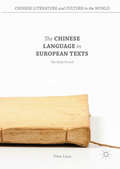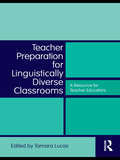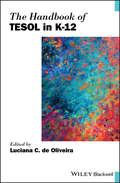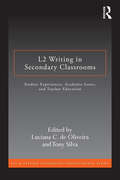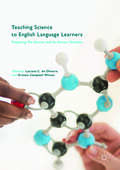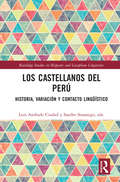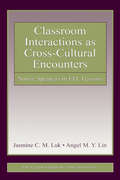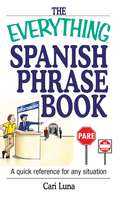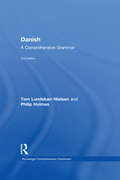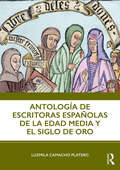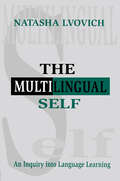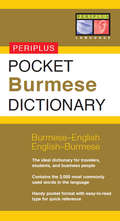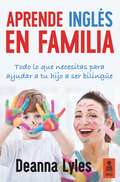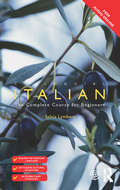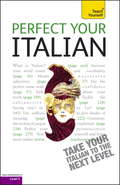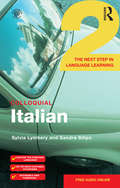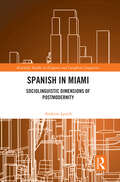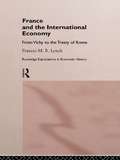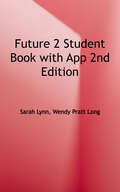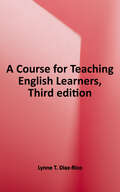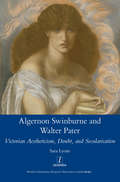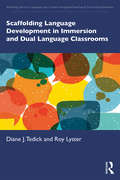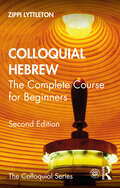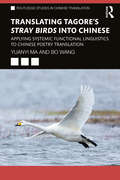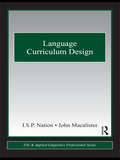- Table View
- List View
The Chinese Language in European Texts
by Dinu LucaThis detailed, chronological study investigates the rise of the European fascination with the Chinese language up to 1615. By meticulously investigating a wide range of primary sources, Dinu Luca identifies a rhetorical continuum uniting the land of the Seres, Cathay, and China in a tropology of silence, vision, and writing. Tracing the contours of this tropology, The Chinese Language in European Texts: The Early Period offers close readings of language-related contexts in works by classical authors, medieval travelers, and Renaissance cosmographers, as well as various merchants, wanderers, and missionaries, both notable and lesser-known. What emerges is a clear and comprehensive understanding of early European ideas about the Chinese language and writing system.
Teacher Preparation for Linguistically Diverse Classrooms: A Resource for Teacher Educators
by Tamara LucasTeacher educators today need knowledge and practical ideas about how to prepare all pre-service and in-service teachers (not just bilingual or ESL specialists) to teach the growing number of students in K-12 classrooms in the United States who speak native languages other than English. This book is at the forefront in focusing exclusively on the preparation of mainstream classroom teachers for this population of students. Part one provides the conceptual and contextual framework for the book, including a comprehensive discussion of relevant demographic trends and an analysis of national and state policies. Part two presents examples of initiatives in different institutional and geographic settings, highlighting three essential elements of teacher preparation: curriculum content, program design, and program coherence. Meeting a pressing need among teacher educators left to figure out, largely by trial and error, how best to prepare non-specialist classroom teachers to work with ELLs, this book both contributes to the research base and provides practical information to help readers envision possibilities they can apply in their own settings.
The Handbook of TESOL in K-12 (Blackwell Handbooks in Linguistics)
by Luciana C. de OliveiraThe first handbook to explore the field of Teaching English to Speakers of Other Languages in elementary and secondary education (K-12) The number of students being educated in English has grown significantly in modern times — globalization, immigration, and evolving educational policies have prompted an increased need for English language learner (ELL) education. The Handbook of TESOL in K-12 combines contemporary research and current practices to provide a comprehensive overview of the origins, evolution, and future direction of Teaching English to Speakers of Other Languages at the elementary and secondary levels (K-12). Exploring the latest disciplinary and interdisciplinary issues in the field, this is a first-of-its-kind Handbook and contributions are offered from a team of internationally-renowned scholars. Comprehensive in scope, this essential Handbook covers topics ranging from bilingual language development and technology-enhanced language learning, to ESOL preparation methods for specialist and mainstream teachers and school administrators. Three sections organize the content to cover Key Issues in Teaching ESOL students in K-12, Pedagogical Issues and Practices in TESOL in K-12 Education, and School Personnel Preparation for TESOL in K-12. Satisfies a need for inclusive and in-depth research on TESOL in K-12 classrooms Presents a timely and interesting selection of topics that are highly relevant to working teachers and support staff Applies state-of-the-art research to real-world TESOL classroom settings Offers a balanced assessment of diverse theoretical foundations, concepts, and findings The Handbook of TESOL in K-12 is an indispensable resource for undergraduate and graduate students, researchers and scholars, and educators in the field of Teaching English to Speakers of Other Languages in elementary and secondary education.
L2 Writing in Secondary Classrooms: Student Experiences, Academic Issues, and Teacher Education (ESL & Applied Linguistics Professional Series)
by Luciana C. de Oliveira Tony SilvaSecond language writers and the teaching of writing at the secondary level have received little attention compared with other skills such as reading. Addressing this gap, this volume uniquely looks at both adolescent L2 writing and the preparation of secondary teachers to work with this population of students. Part I, on adolescent L2 writers, includes case studies looking at their literacy identities, their trajectories in mainstream content area classes, and their transition from high school to college. Part II looks at academic issues. The focus in Part III is L2 writing teacher education. Taking a theoretically eclectic approach that can support a variety of pedagogies, this book contributes significantly to understanding adolescent second language writers and to educating teachers to address these students’ specific needs.
Teaching Science to English Language Learners
by Luciana C. de Oliveira Kristen Campbell WilcoxThis edited collection explores how science can be taught to English language learners (ELLs) in 21st century classrooms. The authors focus on the ways in which pre-service and in-service science teachers have developed--or may develop--instructional effectiveness for working with ELLs in the secondary classroom. Chapter topics are grounded in both research and practice, addressing a range of timely topics including the current state of ELL education in the secondary science classroom, approaches to leveraging the talents and strengths of bilingual students in heterogeneous classrooms, best practices in teaching science to multilingual students, and ways to infuse the secondary science teacher preparation curriculum with ELL pedagogy. This book will appeal to an audience beyond secondary content area teachers and teacher educators to all teachers of ELLs, teacher educators and researchers of language acquisition more broadly.
Los castellanos del Perú: historia, variación y contacto lingüístico (Routledge Studies in Hispanic and Lusophone Linguistics)
by Luis Andrade Ciudad y Sandro Sessarego, eds.Este libro reúne contribuciones de destacados investigadores de la lingüística hispánica para ofrecer un panorama integral de los castellanos del Perú, incluidos algunos que han sido tradicionalmente objeto de discriminación, como el castellano andino, el amazónico y el afroperuano. Los capítulos se concentran en diferentes variedades habladas en el Perú desde distintos enfoques teóricos y metodológicos, atendiendo a su formación, su contexto social e histórico y los fenómenos de contacto que las caracterizan. De este modo, aunque el volumen tiene un foco regional muy específico, los problemas que aborda son de interés y relevancia para el estudio de otras variedades del español, para el tratamiento de otros problemas derivados del contacto lingüístico y para la dialectología e historia de los castellanos latinoamericanos en general. Escrito en castellano, este volumen será de interés para estudiantes graduados en lingüística hispánica e investigadores dedicados a la dialectología, la sociolingüística y la lingüística del contacto.
Classroom Interactions as Cross-Cultural Encounters: Native Speakers in EFL Lessons (ESL & Applied Linguistics Professional Series)
by Jasmine C. Luk Angel M. LinClassroom Interactions as Cross-Cultural Encounters is about native English speakers teaching English as a global language in non-English speaking countries. Through analysis of naturally occurring dialogic encounters, the authors examine the multifaceted ways in which teachers and students utilize diverse communicative resources to construct, display, and negotiate their identities as teachers, learners, and language users, with different pedagogic, institutional, social, and political implications. A range of issues in applied linguistics is addressed, including linguistic imperialism, post-colonial theories, micropolitics of classroom interaction, language and identity, and bilingual classroom practices. Intended to help TESOL professionals of different cultural backgrounds, working in different sociocultural contexts, to critically understand how non-assimilationist, dialogic intercultultural communication with students can be achieved and built on for mutual cultural and linguistic enrichment and empowerment, this book:*emphasizes the sociocultural meanings and micropolitics of classroom interactions that reveal the complex realities of power and identity negotiations in cross-cultural interactions in ELT (English Language Teaching) classroom contexts;*revisits and reconstitutes the notion of native-speakerness and repositions the roles of native and non-native English teachers in the TESOL profession in the contexts of decolonization and globalization; *highlights the need to mobilize intercultural communicative resources for global communication;*addresses two major concerns of EFL (English as a Foreign Language) classroom researchers and teachers: student resistance and learning motivation; and*examines and analyzes the changing ideologies (both explicit and implicit) of teachers and students about English learning in the context of a post-colonial society, and how these ideologies are being enacted, reproduced, but also sometimes contested in EFL classroom interactions. Each chapter includes Questions for Reflection and Discussion to promote critical thinking and understanding of the issues discussed. Tuning-In discussion questions are provided in the three chapters on classroom data analysis to activate readers interpretive schemas before they examine the actual classroom episodes. The data are from an ethnographic study in post-colonial Hong Kong secondary schools involving four native English-speaker teachers and two bilingual Cantonese-English speaking teachers engaged in intercultural classroom dialogues with their Cantonese Hong Kong students. The rich, naturally occurring classroom data and in-depth analyses provide useful pedagogical materials for courses in EFL teacher education programs on classroom discourse analysis from sociocultural perspectives.
The Everything Spanish Phrase Book (The Everything®)
by Cari LunaWith the increase in travel to Spanish-speaking countries as well as the rise in the Latino population in the United States, a growing number of people are in need of a quick reference to help them communicate. Sadly, most Spanish reference books contain outdated phrases organized in a manner that make it difficult to find the right words for the right situation. The Everything Spanish Phrase Book remedies these shortcomings with a practical, real-world approach to language learning that is both quick and easy to use.From ordering dinner and asking for directions to working and communicating in Latino communities, this handy guide provides readers with all they need as ellos hablan español in any setting.Organized by situation, The Everything Spanish Phrase Book contains the right words for:Traveling and making reservationsDining and shoppingSpeaking Spanish in a business settingWorking with the Latino communityFully indexed and complete with a pronunciation guide and helpful dictionaries, The Everything Spanish Phrase Book is the ideal resource for business or pleasure.
Danish: A Comprehensive Grammar (Routledge Comprehensive Grammars)
by Tom Lundskaer-Nielsen Philip HolmesDanish: A Comprehensive Grammar presents a fresh and accessible description of the language, concentrating on the real patterns of use in modern Danish. The volume is organized to promote a thorough understanding of Danish grammar. It offers a stimulating analysis of the complexities of the language, and provides full and clear explanations. This edition has been fully updated to reflect changes in grammar, cultural changes and the impact of modern technology. All sections have been systematically revised, and a new section on phrases and an up-to-the-moment account of the use of the comma have been added. The examples and grammar explanations have been improved throughout. Features include: a wealth of examples from present-day Danish particular attention to areas of confusion and difficulty Danish-English parallels highlighted throughout the book an extensive index and clear paragraph numbering for easy navigation cross-references in all parts of the book. Danish: A Comprehensive Grammar is the most comprehensive and detailed Danish grammar available in English and is an essential reference source for the learner and user of Danish at all levels. It is ideal for use in schools, colleges, universities and adult classes of all types.
Antología de escritoras españolas de la Edad Media y el Siglo de Oro
by Luzmila Camacho Platero; Javier Muñoz-BasolsAntología de escritoras españolas de la Edad Media y el Siglo de Oro ofrece una selección de obras literarias de ocho escritoras medievales, renacentistas y barrocas. Cada capítulo presenta una extensa introducción sobre la autora y su obra. Esta antología contribuye a mejorar el conocimiento de los estudiantes sobre la lengua, la literatura y la cultura españolas, al igual que ofrece una lectura desde la perspectiva de género de estas escritoras. Acompañada de textos originales modernizados al castellano actual, notas aclaratorias, actividades y una extensa y actualizada bibliografía, Antología de escritoras españolas de la Edad Media y el Siglo de Oro muestra la evolución de voces femeninas a lo largo de estos siglos. Las actividades sugeridas para cada capítulo ayudan a exponer y a reflexionar sobre la relevancia cultural que en la actualidad tienen los argumentos que estas mujeres proponent en sus trabajos. Esta antología será de gran utilidad para estudiantes de literatura y cultura españolas de niveles de grado y graduado e, igualmente, para los estudiantes hispanohablantes de literature comparada y de estudios de género.
The Multilingual Self: An Inquiry Into Language Learning
by Natasha LvovichThis book relates the author's stories about how languages have integrated her being, and defined and formed her sense of self. The idea of writing autobiographical stories of her multilingual life came from her long-term commitment to foreign language teaching and from a recent, extremely rich and valuable experience teaching English to immigrants in the U.S. While reading and studying various aspects of second-language-related-theory -- linguistics, psychology, anthropology, and sociolinguistics literature -- the author realized how estranged language learners are from all the research, speculations, hypotheses, and achievements of scholarship. A Russian immigrant, the author tells stories to her ESL students to help them understand why and at what price successful language acquisition and acculturation is realistic. Not only can students learn from her stories which encourage discoveries about their own behaviors or problems, but they might want to respond and tell about their own struggles with a foreign language. By becoming writers and interpreters of her text and by making it their own, students can construct their own virtual texts. The stories told throughout are those of a language learner, who is also a linguist and language teacher. As such, they can bridge the gap between second language research and practical teaching and learning. Moreover, this book can help initiate language learners along with their teachers into scholarship. Second language teachers and graduate students preparing for a teaching career might see this book as an illustration and validation of the studied theory and an inner voice of their students at the same time. Multidisciplinary by nature, it can also be used in several college courses such as cultural anthropology, anthropo- and socio-linguistics, sociology, multicultural education, ethnography, bilingualism, and the study of immigrant experience. There are numerous applications of the book in the educational field at various levels of adult learning programs which might be determined by the objectives and by the instructor's vision of it in the curriculum. It is also intended as a message to the general public and to all thinking individuals in search of identity. It will popularize the idea of the importance of foreign language learning, language education, linguistic literacy, and metalinguistic awareness, of illuminating self-discovery through the treasure of multilingual experience, capable of giving birth to a new, sophisticated, spiritually complex and enriched multicultural identity.
Pocket Burmese Dictionary
by Nyi Nyi Lwin Nolan StephenThis is a pocket sized Burmese DictionaryIntended for use by tourists, students, and business people travelling to Myanmar Pocket Burmese Dictionary is an essential tool for communicating in Burmese. A great way to learn Burmese, it features all the essential Burmese vocabulary appropriate for beginning to intermediate students. It's handy pocket format and easy-to read type will make any future trip to Myanmar much easier. In addition to being an excellent English to Burmese dictionary and Burmese to English dictionary Pocket Burmese Dictionary contains important notes on the Burmese language, Burmese grammar, and Burmese pronunciation. All Burmese word are written in Romanized form as well as authentic Burmese script (mranma akkha.ra) so that in the case of difficulties the book can simply be shown to the person the user is trying to communicate with.This dictionary contains: The 3,000 most commonly used words in the Burmese language. Burmese-English and English-Burmese sections. An introduction to the Burmese language. Romanized Burmese and Burmese script (i>mranma akkha.ra). Information on Burmese grammar. Information on pronouncing Burmese.Other books from this bestselling series you might enjoy include: Pocket Vietnamese Dictionary, Pocket Cambodian Dictionary, Pocket Thai Dictionary, and Pocket Malay Dictionary.
Aprende inglés en familia: Todo lo que necesitas para ayudar a tu hijo a ser bilingüe
by Deanna Lyles¿Has pensado cuánto te gustaría poder hablar inglés con soltura? ¿Y ayudar a que tus hijos lo aprendan de pequeños como tú no pudiste hacerlo? Aprende inglés en familia tiene todo lo que necesitas para conseguir ambos objetivos de forma fácil y divertida. Que dos padres no nativos críen un hijo bilingüe es mucho más fácil de lo que parece, y este libro te proporcionará todo lo que necesitas para llevarlo a cabo. Tras un repaso básico sobre el bilingüismo y cómo se aplica a los niños, aquí encontrarás cientos de palabras y expresiones de la vida diaria, además de un sinfín de trucos y consejos que te enseñarán cómo lograr que tus hijos sean bilingües gracias a las canciones, los juegos, los cuentos, el vocabulario y las expresiones que forman parte de la cultura infantil anglosajona desde hace generaciones. También descubrirás cómo desarrollar un plan de bilingüismo específicamente diseñado para tu familia, para que podáis dar pasos firmes hacia vuestro objetivo. ¿Por qué no empezar a mejorar el inglés de toda la familia hoy mismo?
Colloquial Italian: The Complete Course for Beginners (Colloquial Ser. #Vol. 1)
by Sylvia LymberyColloquial Italian: The Complete Course for Beginners has been carefully developed by an experienced teacher to provide a step-by-step course to Italian as it is written and spoken today. Combining a clear, practical and accessible style with a methodical and thorough treatment of the language, it equips learners with the essential skills needed to communicate confidently and effectively in Italian in a broad range of situations. No prior knowledge of the language is required. Colloquial Italian is exceptional; each unit presents a wealth of grammatical points that are reinforced with a wide range of exercises for regular practice. A full answer key, a grammar summary, bilingual glossaries and English translations of dialogues can be found at the back as well as useful vocabulary lists throughout. Key features include: A clear, user-friendly format designed to help learners progressively build up their speaking, listening, reading and writing skills Jargon-free, succinct and clearly structured explanations of grammar An extensive range of focused and dynamic supportive exercises Realistic and entertaining dialogues covering a broad variety of narrative situations Helpful cultural points An overview of the sounds of Italian Balanced, comprehensive and rewarding, Colloquial Italian is an indispensable resource both for independent learners and students taking courses in Italian. Audio material to accompany the course is available to download free in MP3 format from www.routledge.com/cw/colloquials. Recorded by native speakers, the audio material features the dialogues and texts from the book and will help develop your listening and pronunciation skills.
Perfect Your Italian 2E: Teach Yourself
by Sylvia LymberyAre you looking for an improver's course in Italian which will make you sound like a native? If you already know some Italian and want to take it further, Perfect your Italian will guarantee success! Taking you from a good GCSE level (level B2 of the Common European Framework), this course teaches you advanced structures and vocabulary so that by the end of the course you will be at GCE Advanced Level, CEF level C1: Can express him/herself fluently and spontaneously without much obvious searching for expressions. Can use language flexibly and effectively for social, academic and professional purposes.Full of authentic texts and dialogues about complex subjects, this course covers a wide range of topics of the sort you will want to talk about when in Italy and teaches you the kind of everyday language and features of speech that will enable you to communicate with confidence and feel comfortable taking part in conversation with native speakers of Italy. The choice of material aims to give you something of the flavour of Italy today and each unit is based around a single theme with lively interviews and conversations on the accompanying recording. There are activities based on the interviews and texts to help you remember what you've learnt and put your knowledge into practice. The units are divided into sessions - to help you organize your learning time and break up the material into manageable chunks - and there are reminders throughout to refresh your memory of points you have learnt.Now fully updated to make your language learning experience fun and interactive. You can still rely on the benefits of a top language teacher and our years of teaching experience, but now with added learning features within the course and online.Learn effortlessly with new, easy-to-read page design and interactive features:/p>NOT GOT MUCH TIME?One, five and ten-minute introductions to key principles to get you started.AUTHOR INSIGHTSLots of instant help with common problems and quick tips for success, based on the author's many years of experience.GRAMMAR TIPSEasy-to-follow building blocks to give you a clear understanding.USEFUL VOCABULARYEasy to find and learn, to build a solid foundation for speaking.DIALOGUESRead and listen to everyday dialogues to help you speak and understand fast.TEST YOURSELFTests in the book and online to keep track of your progress.EXTEND YOUR KNOWLEDGEExtra online articles at: www.teachyourself.com to give you a richer understanding of the culture and history of Italy.TRY THISInnovative exercises illustrate what you've learnt and how to use it.
Colloquial Italian 2: The Next Step in Language Learning (The\colloquial 2 Ser.)
by Sylvia Lymbery Sandra SilipoDo you know Italian already and want to go a stage further? If you're planning a visit to Italy, need to brush up your Italian for work, or are simply doing a course, Colloquial Italian 2 is the ideal way to refresh your knowledge of the language and to extend your skills. Colloquial Italian 2 is designed to help those involved in self-study; structured to give you the opportunity to listen to and read lots of modern, everyday Italian, it has also been developed to work systematically on reinforcing and extending your grasp of Italian grammar and vocabulary. Key features of Colloquial Italian 2 include: Revision material to help consolidate and build up your basics A wided range of contemporary authentic documents, both written and audio Lots of spoken and written exercises in each unit Highlighted key structures and phrases, a Grammar reference and detailed answer keys A broad range of situations, focusing on day to day life in Italy. Audio material to accompany the course is available to download free in MP3 format from www.routledge.com/cw/colloquials. Recorded by native speakers, the audio material features the dialogues and texts from the book and will help develop your listening and pronunciation skills.
Spanish in Miami: Sociolinguistic Dimensions of Postmodernity (Routledge Studies in Hispanic and Lusophone Linguistics)
by Andrew LynchSpanish in Miami reveals the multifaceted ways in which the language is ideologically rescaled and sociolinguistically reconfigured in this global city. This book approaches Miami’s sociolinguistic situation from language ideological and critical cultural perspectives, combining extensive survey data with two decades of observations, interviews, and conversations with Spanish speakers from all sectors of the city. Tracing the advent of postmodernity in sociolinguistic terms, separate chapters analyze the changing ideological representation of Spanish in mass media during the late 20th century, its paradoxical (dis)continuity in the city’s social life, the political and economic dimensions of the Miami/Havana divide, the boundaries of language through the perceptual lens of Anglicisms, and the potential of South Florida—as part of the Caribbean—to inform our understanding of the highly complex present and future of Spanish in the United States. Spanish in Miami will be of interest to advanced students and researchers of Spanish, Sociolinguistics, and Latino Studies.
France and the International Economy: From Vichy to the Treaty of Rome (Routledge Explorations in Economic History)
by Frances LynchThis is a comprehensive history of a critically formative period in French economic history. Frances Lynch covers topics such as the post-war negotiations for American aid, the reconstruction of a capital market, the modernization of French agriculture, the liberalization of trade in the 1950s and subsequent economic growth.
Future 2 Student Book With App
by Sarah LynnSince it was first published, Future has helped over half a million students learn English and achieve their personal, career, and educational goals. Now in its second edition, this effective six-level program continues to address the diverse needs of adult learners, equipping them with transferrable academic, workplace, and English communication skills. Future, Second Edition supports the Workforce Innovation and Opportunity Act (WIOA) goals and helps students develop the skills outlined in the College and Career Readiness Standards and the English Language Proficiency Standards. New to this edition - Updated content exposes students to language and concepts used in workplace, school, and community settings. - More workplace vocabulary and skills, and functional language prepare learners for career success. - New content-rich readings with level-appropriate text complexity build content knowledge, introduce academic vocabulary, and require learners to analyze text and cite evidence to extend their learning. - New writing lessons focus on analyzing models, brainstorming, organizing ideas, and synthesizing unit learning into well-organized writing outcomes. - New Soft Skills at Work lessons help learners develop essential social and cultural skills, critical to career advancement and success. - Increased rigor built into all lessons at every level challenges learners to analyze, evaluate, predict, infer, and problem-solve. - Enhanced unit goals and lesson objectives ensure learners track and reflect on their own progress. Other highlights - Latest digital tools help develop students’ digital skills. - Research-based teaching strategies provide creative solutions for all stages of lesson planning and implementation. - Comprehensive digital and print resources for teachers enhance classroom instruction and simplify lesson planning. - Correlations to standards guide and support teachers in aligning their instruction with current standards. - Mapped to the Global Scale of English.
A Course for Teaching English Learners
by Lynne T. Diaz-RicoPrinciples and classroom techniques for teaching English language learners A Course for Teaching English Learners combines the fundamental principles of education with practical English language education techniques to help both pre- and in-service educators reach English language students in impactful ways. <p><p>The text provides background in cultural, linguistic, and sociocultural context, building a comprehensive framework for effective English language education. Uniquely, the text outlines both psychological and sociocultural contexts at play at all school levels, including second-language acquisition hurdles and strategies for teaching content subjects. <p><p>The 3rd Edition has been updated with a wealth of new and revised content, including new information on evolving certification requirements, modern demographic data, technology-enhanced language learning, translanguaging, and more.
Algernon Swinburne and Walter Pater: Victorian Aestheticism, Doubt and Secularisation
by SarahGlendon LyonsHow did literary aestheticism emerge in Victorian Britain, with its competing models of religious doubt and visions of secularisation? For Lyons, the aestheticism developed and progressively revised by Algernon Charles Swinburne (1837-1909) and Walter Pater (1839-1894) illuminates the contradictory impulses of modern secularism: on the one hand, a desire to cast itself as a form of neutrality or disinterestedness; on the other, a desire to affirm 'this world' as the place of human flourishing or even enchantment. The standard narrative of a 'crisis of faith' does not do justice to the fissured, uncertain quality of Victorian visions of secularisation. Precisely because it had the status of a confusing hypothesis rather than a self-evident reality, it provoked not only dread and melancholia, but also forms of fantasy. Within this context Lyons gives a fundamentally new account of the aims and nature of Victorian aestheticism, taking as a focus its deceptively simple claim that art is for art's sake first of all.
Scaffolding Language Development in Immersion and Dual Language Classrooms (Routledge Series in Language and Content Integrated Teaching & Plurilingual Education)
by Roy Lyster Diane J. TedickThis book introduces research-based pedagogical practices for supporting and enhancing language development and use in school-based immersion and dual language programs in which a second, foreign, heritage, or indigenous language is used as the medium of subject-matter instruction. Using counterbalanced instruction as the volume’s pedagogical framework, the authors map out the specific pedagogical skill set and knowledge base that teachers in immersion and dual language classrooms need so their students can engage with content taught through an additional language while continuing to improve their proficiency in that language. To illustrate key concepts and effective practices, the authors draw on classroom-based research and include teacher-created examples of classroom application. The following topics are covered in detail: defining characteristics of immersion and dual language programs and features of well-implemented programs strategies to promote language and content integration in curricular planning as well as classroom instruction and performance assessment an instructional model to counterbalance form-focused and content-based instruction scaffolding strategies that support students’ comprehension and production while ensuring continued language development an approach to creating cross-linguistic connections through biliteracy instruction a self-assessment tool for teachers to reflect on their pedagogical growth Also applicable to content and language integrated learning and other forms of content-based language teaching, this comprehensive volume includes graphics to facilitate navigation and provides Resources for Readers and Application Activities at the end of each chapter. The book will be a key resource for preservice and in-service teachers, administrators, and teacher educators.
Colloquial Hebrew: The Complete Course for Beginners
by Zippi LyttletonColloquial Hebrew provides a step-by-step course in Hebrew as it is written and spoken today. Combining a user-friendly approach with a thorough treatment of the language, it equips learners with the essential skills needed to communicate confidently and effectively in Hebrew in a broad range of situations. No prior knowledge of the language is required. Balanced, comprehensive and rewarding, this fully revised new edition of Colloquial Hebrew is an indispensable resource for both independent learners and students taking courses in Hebrew. This edition features an engaging story line throughout the book, encouraging the student to form dialogues and develop conversational skills. Key features include: • progressive coverage of speaking, listening, reading and writing skills • realistic and entertaining dialogues covering a broad variety of scenarios • translations and transliteration provided throughout in the key • structured, jargon-free explanations of grammar • an extensive, varied range of focused and stimulating exercises • useful vocabulary lists throughout the text • additional resources available at the back of the book and on the web, including a full answer key, a grammar summary, a list of verbs used in the book, a prepositions chart and glossaries Audio material to accompany the course is available to download free in MP3 format from www.routledge.com/cw/colloquials. Recorded by native speakers, the audio material features the dialogues and exercises from the book and will help develop your listening and pronunciation skills.
Translating Tagore's Stray Birds into Chinese: Applying Systemic Functional Linguistics to Chinese Poetry Translation (Routledge Studies in Chinese Translation)
by Yuanyi Ma Bo WangTranslating Tagore’s ‘Stray Birds’ into Chinese explores the choices in poetry translation in light of Systemic Functional Linguistics (SFL) and illustrates the ways in which readers can achieve a deeper understanding of translated works in English and Chinese. Focusing on Rabindranath Tagore’s ‘Stray Birds’, a collection of elegant and philosophical poems, as a source text, Ma and Wang analyse four Chinese target texts by Zheng Zhenduo, Yao Hua, Lu Jinde and Feng Tang and consider their linguistic complexities through SFL. This book analyses the source text and the target texts from the perspectives of the four strata of language, including graphology, phonology, lexicogrammar and context. Ideal for researchers and academics of SFL, Translation Studies, Linguistics, and Discourse Analysis, Translating Tagore’s ‘Stray Birds’ into Chinese provides an in-depth exploration of SFL and its emerging prominence in the field of Translation Studies.
Language Curriculum Design: Concepts And Approaches In Action Around The World (ESL & Applied Linguistics Professional Series)
by John Macalister I.S.P NationCrystal-clear and comprehensive yet concise, this text describes the steps involved in the curriculum design process, elaborates and justifies these steps, and provides opportunities for practicing and applying them. The description of the steps is done at a general level so that they can be applied in a wide range of particular circumstances. The process comes to life through plentiful examples of actual applications of the steps. Each chapter includes: examples from the authors' experience and from published research tasks that encourage readers to relate the steps to their own experience case studies and suggestions for further reading that put readers in touch with others' experience Curriculum, or course, design is largely a 'how-to-do-it' activity that involves the integration of knowledge from many of the areas in the field of Applied Linguistics, such as language acquisition research, teaching methodology, assessment, language description, and materials production. Combining sound research/theory with state-of-the-art practice, Language Curriculum Design is widely applicable for ESL/EFL language education courses around the world.
